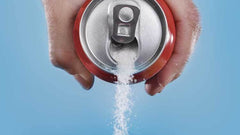
Low Sugar Diet Guide - What Foods to Include in Your Diet Plan
We don’t intend to alarm you – but there’s something lurking in your food. From the ketchup you put on your fries to the cereals you eat for breakfast, and even to the dressings you put on your salads, a highly addictive substance is hiding in almost everything you eat, even the foods where you’d least expect it to be.
So what is it? Is it fat? Is it cholesterol? No, it’s actually sugar. While sugar is a relatively harmless carbohydrate in its natural state, the fact of the matter is that we’re eating way too much of the sweet stuff. A CDC report revealed that an average American consumes 13 to 20 teaspoonfuls of added sugar on a daily basis. Therefore, it’s no surprise that sugar has been dubbed as the “new tobacco”.
Consuming excessive amounts of added sugars can affect your health in a variety of ways, the most obvious ones being obesity and major weight gain. Read on to discover why switching to a low sugar diet is one of the healthiest decisions you can make today.
The Link Between Sugar and Obesity
Benefits of a Low Sugar Diet for Weight Loss
Benefits of a Low Sugar Diet for Other Medical Conditions
What Foods to Eat
What Foods to Avoid
Tips for Shopping to Choose the Right Foods
The Perfect Low-Sugar Meal Plan

The Link Between Sugar and Obesity
An increasing number of medical studies and research are coming to the conclusion that there’s a direct relationship between the consumption of unhealthy sugar-sweetened foods and weight gain. Not only are such foods and drinks a major source of unnecessary calories, but they also provide little to no nutritional value.
Back in 2010, a systematic literature review was commissioned by the WHO to address a series of long-standing questions regarding sugars’ effects on excess adiposity. These questions were mainly related to whether increasing or decreasing the consumption of dietary sugars had any impact on the body fat levels of children and adults, and whether the existing evidence was substantial enough to support recommending a reduced free sugar intake of lower than 10% of the total energy consumption. The fatness of the body was chosen as the outcome considering the extent to which obesity’s comorbidities contribute to the overall global burden of diseases that are non-communicable.
The data from the meta-analysis indicates that the variations in body fat levels that occur as a consequence of modifying sugar intake actually results because of a change in the balance of energy, rather than a metabolic or physiological consequence of disaccharides or monosaccharides.
As the causes of obesity are multifactorial, it’s not surprising that the impact of reducing sugar intake is relatively insignificant. But, when you consider how rapidly weight increases when you increase sugar intake, it makes perfect sense to conclude that the recommendations regarding sugar intake are a valid part of strategies for reducing the risk of obesity.

Benefits of a Low Sugar Diet for Weight Loss
Adhering to a low-sugar diet is unquestionably one of the best ways to lose weight. While a teaspoon of sugar contains only a meager 16 calories, we consume a large amount on a daily basis as it’s present in almost all types of foods we eat these days. Junk foods, sugary foods, sodas, colas, and even fruits – all contain copious amounts of sugar. Reducing sugar from your diet helps you cut back a significant amount of calories, thereby helping you lose weight.
Sodas and sugary beverages, in particular, contain obscene amounts of sugar. According to the American Heart Association, a regular 12 ounce can of soda contains a whopping 8 teaspoons of sugar. That translates to 132 calories just in sugar, with zero nutritional benefits.
According to the CDC, you need to burn off 3500 calories in order to lose about half a kilo. As we’ve already mentioned, there are 16 calories in a teaspoonful of sugar. Therefore, if you cut out foods from your diet that have 10 teaspoons of sugar, you’re cutting out 160 calories on a daily basis, and 1120 calories on a weekly basis. Combine this with your normal physical activity, and you’ll lose half a kilo every 3 weeks.
However, it’s impossible to completely cut out sugar from your diet, and you shouldn’t do so as well. It’s also worth noting that not all types of sugars are bad. Consuming sugar in its natural form is completely okay. What you should completely avoid are sucrose (refined table sugar) and high-fructose foods and drinks such as corn syrup.
Benefits of a Low Sugar Diet for Other Medical Conditions
Reducing your sugar intake not only helps you lose weight but also helps you to prevent or control a variety of other health conditions and disorders. Let’s have a look at them.
Helps Prevent Type II Diabetes
When your diet consists of a lot of quick-digesting carbohydrates, such as sugars, it puts your pancreas under a lot of stress. It has to constantly produce the hormone “insulin” to break down the sugar. This constant stress can have an impact on the insulin-producing cells in the body, potentially affecting their ability to perform and causing them to malfunction, gradually resulting in diabetes.
When you reduce your sugar intake, the demand on your pancreas decreases, allowing it to perform and function optimally.

Maintains Good Heart Health
The heart is your body’s engine. It enables you to power through everything – from intense workout sessions to demanding work deadlines. However, by filling up with caramel lattes and chocolate-chip cookies, you aren’t doing your heart any favors. Research conducted at the Harvard Medical School reveals that excessive intake of added sugars increases the risk of cardiovascular diseases.
The study was a comprehensive one and was conducted over a span of 15 years. Researchers discovered that the participants whose daily sugar intake accounted for 25% of their entire calorie intake were more than twice as likely to die of cardiovascular disease compared to participants whose diets had less than 10% added sugar.
Therefore, cutting back on the added sugar you consume will definitively lower the risk of cardiovascular diseases.
Helps Prevent Tooth Decay
Amidst all the serious health conditions and diseases associated with high sugar intake, one of the more basic damages it causes is overlooked: tooth decay. When sugar is left sitting on your teeth, it causes more damage and destruction on your teeth than perhaps any other substance. Here’s a video demonstrating the damage soda inflicts upon your teeth:
Therefore, switching to low sugar foods can help you ensure that your set of permanent natural teeth can last as long as possible.
What Foods to Eat
When you start a low sugar diet, your main focus should be replacing the added sugar with naturally sweet foods such as fruits, some vegetables, spices, natural dairy and whole grains. You’d also want to integrate foods that have a rich amount of proteins, healthy fats and fiber. They will help in keeping your blood sugar levels stabilized and prevent cravings. Many of these foods can also be used in recipes to help you feel fuller for longer. Below is a list of the best foods for low blood sugar.
Fiber Rich Fruits
Fiber-rich fruits are a staple of any low sugar diet plan. These are some fruits that should be on your grocery list:
- Blueberries
- Blackberries
- Apples
- Avocados
- Raspberries
- Coconuts
- Pears
- Cranberries
- Pomegranates
- Oranges
Fiber Rich Vegetables
When it comes to vegetables, you aren’t really bound specific options. Honestly, when it comes to a low-sugar diet, you’re good to go with any vegetable. However, here are some fiber-rich vegetables that you can easily find at your local farmer’s market or grocery store:
- Green peas
- Broccoli
- Kale
- Spinach
- Zucchini
- Cauliflower
- Swiss Chard
- Butternut squash
- Sweet potato
- Artichoke hearts
- Parsnips
- Fennel
- Spaghetti squash

Non-Dairy & Dairy Products
You have to be careful when selecting non-dairy and dairy products as added sugars can be quite sneaky. However, if you opt for plain, you should be good to go. Here are the foods that should be on your list:
- Cheeses
- Almond milk
- Coconut milk
- Cashew milk
- Dairy milk
- Coconut yoghurt
- Skyr
- Greek yogurt
- Kefir
Whole Grains
Contrary to popular belief, carbs are not the devil that they have been painted as. In fact, we need 120 grams of carbs a day to support our brain. It’s the added sugar that you need to watch out for. Therefore, read the label carefully when shopping for whole grain foods. Below are the ideal whole grain foods that you should be looking to incorporate into your low blood sugar diet:
- Brown rice
- White rice
- Barley
- Quinoa
- Oats
- Wild rice oats
- Millet
- Farro
- Buckwheat
Protein-Rich Foods
If you can manage to steer clear of the ultra-sugary sauces, lean proteins are an excellent component of a low-sugar diet. Here are some examples:
- Chicken breasts
- Salmon
- Beef tenderloin
- Tuna
- Tofu
- Shrimp
- Legumes
- Beans
What Foods to Avoid
Now that we’ve gone over the low-sugar foods that you should be eating, let’s delve into the ones that you should be avoiding. They include:
- Foods that contain high amounts of added sugar. These include granola bars, flavored yogurt, and breakfast cereals.
- High-calorie coffees
- Alcoholic drinks
- Fizzy drinks
- Cookies, pastries, and cakes
- Processed fruit juices
- Candy bars
- White bread
- Potato chips and French fries.
Tips for Shopping to Choose the Right Foods
Once you’ve identified the foods that are perfect for a low-sugar diet, grocery shopping actually becomes a lot easier. However, it’s really important to read the labels carefully as added sugars can sneak into your shopping cart if you’re not wary. Here are some grocery shopping tips to choose the right foods.
Dairy Products
- Look for low-sugar and low-fat yoghurts that have minimal added sugars and saturated fats.
Breakfast Cereals
- Choose wholegrain products that are high in fiber and don’t contain any added sugars.
Baked Goods and Breads
- To make your meals interesting, buy multiple types of breads such as wraps, rolls, tortillas, pitas and crumpets.
- Make sure you choose from wholegrain varieties.
- Steer clear of baked cakes, pastries and biscuits.
Tinned Fruits
- Opt for fruits that are tinned in natural juice that don’t contain added sugars.
- Avoid processed fruit juices and dried fruits that are high in added sugar.
The Perfect Low-Sugar Meal Plan
When you start a low-sugar diet, the initial stage is the toughest. As your body has become used to a high-sugar intake, reducing it significantly and abruptly can cause disturbances in your mood and energy levels. We’ve devised the perfect 7-day meal that’ll help keep your blood sugar balanced and your mood regulated:
Conclusion
Obesity and overweight have become a global concern and excessive sugar consumption is one of the main culprits behind it. In addition to obesity, excessive added sugars have been linked with a wide array of medical conditions including cardiovascular issues, diabetes, high cholesterol, and hypertension.
A low sugar diet not only helps in achieving weight loss but it also reduces the risk of all of the aforementioned conditions. Replacing high-sugar foods with naturally sweet and healthy alternatives can help a person get all the essential minerals and nutrients without the adverse effects of added sugars.
PhenQ manufactures natural supplements to help treat obesity. In addition to our state-of-the-art supplement solutions, our blogs include health and wellness plans to help our readers live a long and healthy life. Get in touch with us today for more information on our products or read our blogs to learn how you can live a wholesome life.




